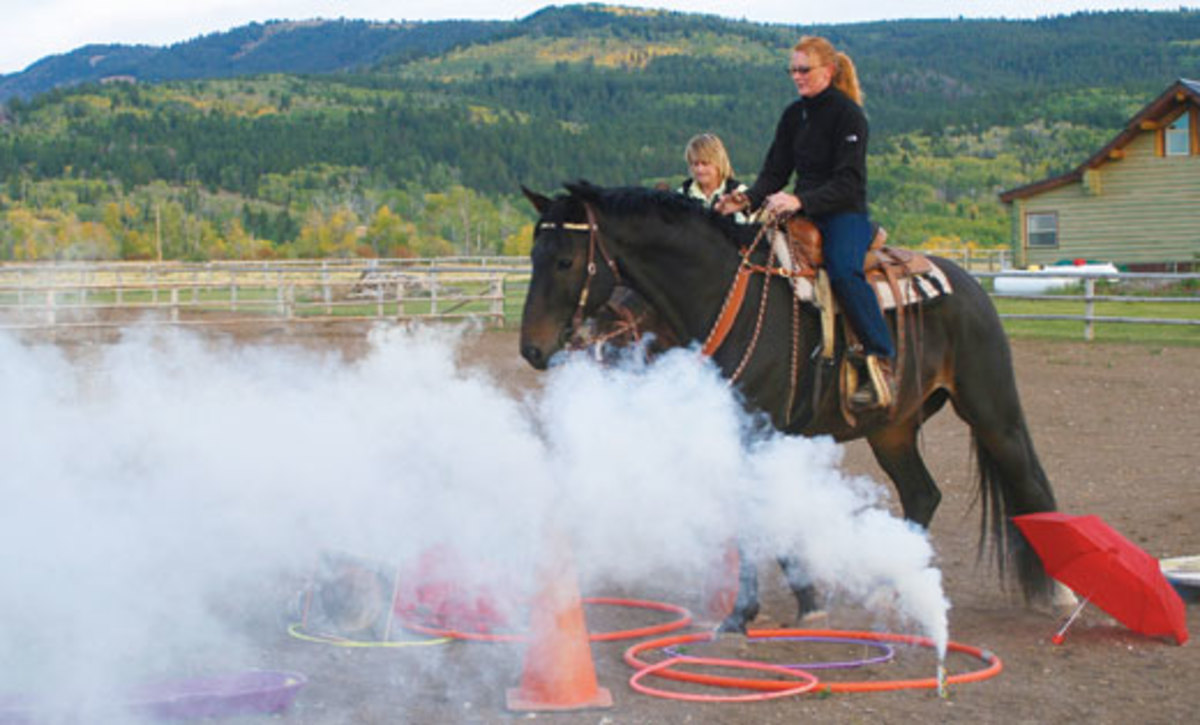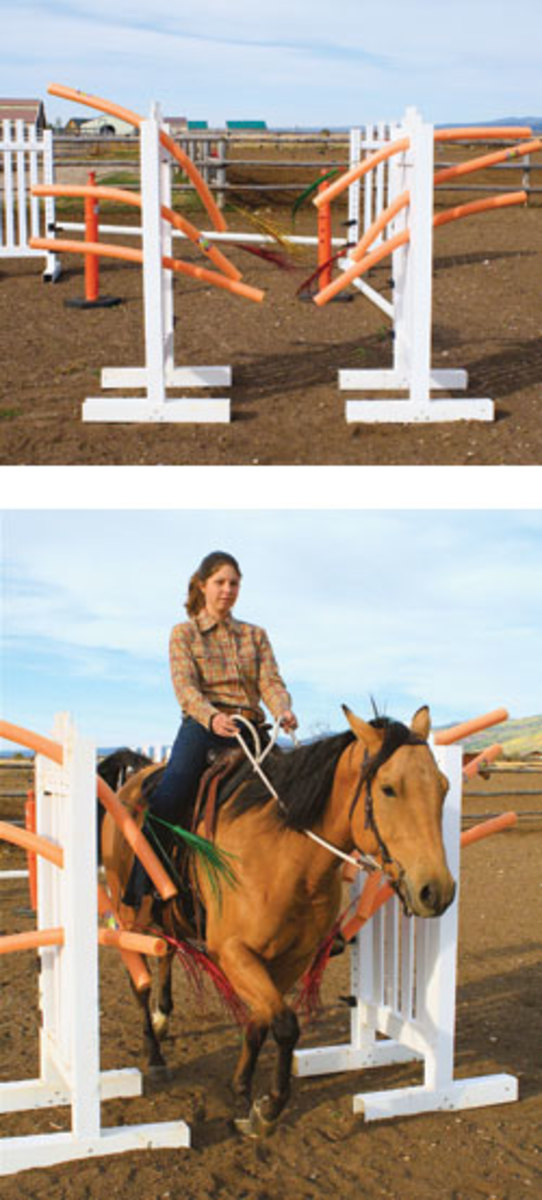
While his wife, Ann, trots her Morgan gelding, Bez, in a circle, Jeb Moyer lights the fuses on two Roman candles and fires them off over the pair. Sparks fly, and fireballs shoot skyward, crackle, and explode, but Bez barely flinches. Ann smiles. Bez wasn’t always this calm.
[READ: Warwick Schiller & Desensitization]
Ann Moyer is one of 27 members of the Jackson Hole Police Citizens’ Mounted Unit (CMU), volunteers who patrol downtown streets and special events. For two years, Ann has been training Bez to accept the noises, crowds, and movements of the town. The training also has had an unintended consequence: Bez has become a better trail horse.
An awesome 97 percent of the country surrounding Jackson, Wyoming, is rideable federal land. The Snake River, Wind River, Gros Ventre and Teton mountain ranges, and Grand Teton and Yellowstone parks are the playgrounds of CMU members, who spend much more time on trails than on patrol.
While trail riding, members have noticed a remarkable contrast in performance between their non-police horses and those trained for mounted patrol. Because of this difference, several members now train all of their horses using the CMU techniques.
The training has been transformative. Heidi Hansen took her new 4-year-old Quarter Horse filly through the mounted police training program. Now the filly is more confident and rarely spooks.
Tressa Allen and her 17-hand Dutch Warmblood, Sheldon, are the unit’s “strongest pair.” Smoke grenades, M-80s, jackhammers, screaming crowds – nothing fazes Sheldon, on the street or on the trail. Allen credits seven years of mounted police training.
As a trail-horse owner, this article can help you recognize the benefits of mounted police desensitization training and incorporate elements into your own training program. We’ll give you ground rules, training basics, and a step-by-step technique.
Through mounted police desensitization, your trail horse will learn to manage his emotions and will gain confidence and trust. When he encounters a scary situation, he’ll be less likely to react negatively. Generally, the scariness of mounted police desensitization exceeds anything you and your horse will experience on the trail.
To learn more, sign up for a clinic offered by a mounted police trainer in your own community, or find a private trainer to help you. Then watch your trail horse transform!
[READ: Building a Connection With Your Horse]
Ground Rules
Before you begin any type of desensitization training, understand the following ground rules:
• Safety first. If you feel in danger, dismount. Work your horse from the ground until he’s comfortable. Note that some exercises and disciplines should be taught only by a professional mounted patrol trainer.
• Watch your pace. Expose your horse only to what he can handle; never push him beyond his limits. Proceed at a pace that helps him succeed.
• Never train alone. Make sure someone is around, even if it’s a neighbor watching from afar.
• Repetition is everything. Mounted patrol training is an ongoing process, not a one-time event.
• Choose skills wisely. Some mounted patrol skills – such as formation riding or crowd control – don’t directly apply to you as a trail rider, so you can decide whether to learn or skip these.

Training Basics
As you begin to work with your horse, keep these training basics in mind to optimize your success.
• Use your mind as a tool. Your mindset, outlook, energy, and anxiety level affect your horse more than any other tool or technique. Corporal Russ Ruschill, a sworn officer in the Jackson Hole unit, believes that 80 percent of horse problems experienced in training are created or worsened by the rider’s own mind.
• Be aware of your energy. You’re the most important factor influencing your horse’s behavior. When you encounter frightening obstacles or loud noises, you may naturally anticipate that your horse will have a negative reaction, such as flinching or bolting. That very expectation could result in a self-fulfilling prophecy. Your horse soaks up your energy like a sponge soaks up water. If you ride over and through obstacles as if they’re no big deal, your horse will adopt the same attitude.
If you feel tense in any situation, ride away from the source of your tension and breathe deeply several times. Relax, and repeat aloud, “No big deal,” or “No problem.” When you convince yourself, your horse will believe you, and you’ll be ready to try again.
The energy of other horses – especially the closest ones – will affect your mount. The best way for a horse to remain calm is to be near an experienced horse whose energy and confidence are contagious.
• Focus on your destination. When you’re in the saddle, your horse will follow your gaze. Hunter/jumper riders look in the direction they want to go before they land a jump. Similarly, rather than focusing on a trail obstacle, establishing it as the endpoint, act as though it doesn’t exist. Keep your chin high, and look at your destination. Pick out a tree, a sign at the far end of the arena – any object in the direction of your destination – and focus on it.
Members of the CMU constantly admonish one another, “Look up” or “Look where you want to go.” This will feel awkward at first, but with time and practice it’ll become more natural. When you set your intention and gaze ahead, then you’re ready to apply physical cues.
• Use the principle of pressure and release. With all forms of equine training, the basics of pressure and release apply. Maintain pressure (e.g., hold the lead rope taut, maintain pressure on the bit, or apply a leg cue) until your horse gives you the slightest approximation of what you want. Then release the pressure, and reward him with a rub.
• Pause for the moment of learning. Your horse learns nothing while you apply or maintain pressure. Learning happens when you release the pressure at a specific response from your horse. Then it’s as if your horse says, “Oh, I get it. That’s what she wants me to do.” During this crucial learning moment, it’s very important that you pause long enough for the lesson to sink in. For every second spent applying pressure, allow the same time for your horse to absorb the lesson. Not pausing long enough for the lesson to settle will make him frustrated and stunt his learning.
• Use your horse’s sense of smell. The horse’s sense of smell often is underestimated. When approaching a new obstacle, you’ll notice that your horse may pause for a sniff. This isn’t a delay tactic or a refusal; it’s part of the acceptance process. Smelling an object indicates that he’s willing to consider dealing with it. After he seems satisfied, ask him to continue forward across or through the obstacle.

Step-by-Step Technique
Now, here’s how to begin desensitization training with your trail horse.
Step 1. Warm up. As with any training regimen, warming up is essential. Most mounted patrol programs use specific warm-up exercises that you can learn about, but at least use whatever exercises you normally use.
Step 2. Sack out your horse. Desensitize your horse’s entire body – over, under, in front, and behind. To do this, rub his whole body with different objects, and allow him to hear all the different sounds they make. Start with an inflatable toy, then graduate to grocery bags, garbage bags, and tarps. Crinkle a paper map; shake your slicker.
Step 3. Use smoke and fire. For advanced desensitization, smoke bombs and fireworks work well. Smoke – an exceptional tool – teaches your horse to trust you enough to penetrate a wall he can’t see through. Light two smoke bombs, place them far apart, send your horse from the ground, then ride in a line of horses between the bombs. As the horses relax, move the smoke bombs closer together, and make several passes.
Fireworks prepare horses to handle unexpected and loud noises. First, explode a single firecracker from 100 yards or more away. Gradually, over a period of days or even weeks, move closer until you can explode a firecracker a few feet away without your horse reacting.
Next, move back 100 yards and explode a string of three or four firecrackers, again moving closer as your horse becomes desensitized. Repeat the process, working up to bottle rockets, M-80s, and Roman candles. When your horse can handle the explosions, ride with others in a circle around a large arena, and ask one person to light fireworks from the center. As the horses accept the fireworks, gradually narrow the circle until everyone is within feet of the explosions. Enlarge the circle, and add smoke grenades and scarier fireworks to the mixture.
[READ ABOUT: Mounted Shooting]
Step 4. Introduce from the ground. When first introducing your horse to any obstacle, do so from the ground until he seems comfortable. If it takes him 45 minutes to simply place one foot on a tarp or to take one step toward a gate, fine. Help him win. Be confident and firm, but never force or overpressure him. Pressuring him would cause him to associate tension with the obstacle. The level of adrenaline is inversely proportional to learning: Adrenaline up, learning down. Adrenaline down, learning up.
There are several favorable ways to get your horse over or through an obstacle. Sergeant Alan John, the founder of the Jackson Hole CMU, instructs his students to first send their horses in small circles, longeing them from the ground. He insists his students practice this skill to perfection before they introduce obstacles. Never ride your horse over an obstacle without first sending him over it from the ground.
Step 5. Ride over the obstacles. After you’ve worked all the obstacles from the ground, it’s time to ride over them. Go easy at first, then, over time, ramp up the difficulty. If your horse refuses an obstacle, follow a more experienced horse. If your horse becomes too uptight with the obstacles, take a break, and play a game. Toss a ball back and forth among riders, play football from horseback, or knock a soccer ball around the arena with brooms.
Step 6. Follow up with trail miles. Trails pose new and different situations from those in mounted patrol training. An experienced New York City police horse on its first Rocky Mountain trail might bolt at the sound of a bugling elk or the smell of a bear. For a trail horse, there is no substitute for trail miles. But generally, mounted patrol desensitization will help your horse to remain calm during scary trail situations.
Step 7. Design your own obstacles. Mounted law enforcement units nationwide use similar training tools and obstacles, but there is no uniform course of study. A little imagination and creativity – combined with items purchased at your local hardware or dollar store – are all the props needed for building obstacles. Replicate the obstacles in these photos or design your own. If you have fun and view the training as a game, your horse will, too.




